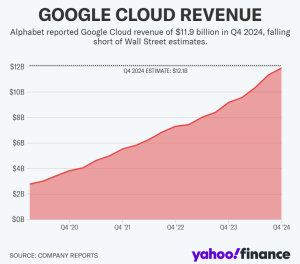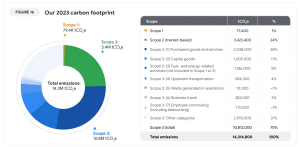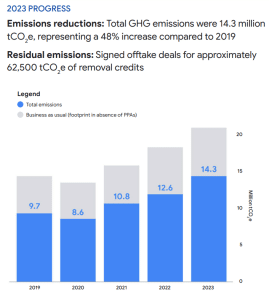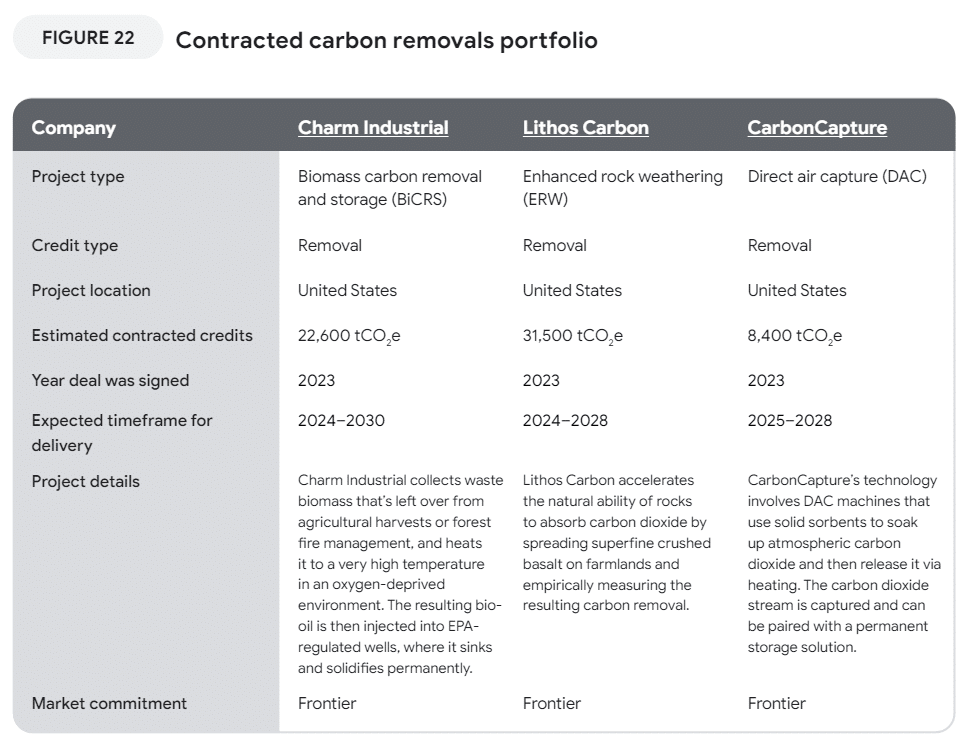Alphabet, Google’s parent company, posted strong Q4 earnings, but its cloud revenue missed expectations. While AI and data center expansion drive growth, emissions are rising. Can Google keep up its net-zero goal while scaling its tech ambitions?
Alphabet’s Financial Snapshot: A Strong Q4 with a Cloud Slip
Alphabet had a great fourth quarter. Their earnings per share (EPS) were $2.15, beating Wall Street’s estimate of $2.13. The company’s total revenue reached $96.4 billion, slightly below the expected $96.6 billion.
Advertising is still Alphabet’s main source of income. It brought in $72.4 billion, which is more than the expected $71.7 billion.
However, Google’s cloud segment fell short, earning $11.9 billion instead of the expected $12.1 billion. This shortfall hurt investor confidence, causing Alphabet’s stock to drop 7% in early trading.

Despite this, Alphabet is boosting investments in artificial intelligence (AI) and cloud services. The company will raise capital spending from $57.9 billion to $75 billion by 2025. This will focus on AI-driven products and expanding data centers. This move aligns with competitors like Meta and Microsoft, which are also betting heavily on AI to enhance user engagement and ad revenue.
Alphabet’s cloud growth is crucial as it competes with Amazon Web Services (AWS) and Microsoft Azure. While Microsoft’s cloud revenue grew 21% year over year to $40 billion, it still fell short of Wall Street’s $41.1 billion forecast.
Google aims to be one step ahead by enhancing its cloud offerings and leveraging AI to attract enterprise clients. Remarking on this during the earnings call, CEO Sundar Pichai stated:
“Our sophisticated, global network of cloud regions and data centers provides a powerful foundation for us and our customers, directly driving revenue. We have a unique advantage because we develop every component of our technology stack, including hardware, compilers, models and products. This approach allows us to drive efficiencies at every level, from training and serving, to developer productivity.”
The company is facing more competition in AI from DeepSeek, a China-based firm. Their new models are cost-effective and very capable. DeepSeek’s rise has sparked worries about Alphabet’s AI leadership. This new technology could shake up the industry.
Even with these challenges, Alphabet’s stock rose by 41% in the past year. This beats Amazon’s 39% gain and far surpasses Microsoft’s 2% increase.
As Alphabet expands its AI and cloud businesses, its energy use keeps growing. To meet its net-zero goals, Google must find cleaner ways to power its data centers.
Google’s Path to Net Zero: Can It Deliver by 2030?
Google aims to achieve net-zero emissions across its operations and value chain by 2030. They have two key strategies: reducing emissions and handling leftover emissions through carbon removal.
In 2023, total GHG emissions reached 14.3 million tCO₂e. This marks a 13% increase from last year, but it’s slower than in the past two years. This increase was mainly due to increased data center energy consumption and supply chain emissions.
Google’s Scope 1 emissions were about 79,400 tCO2e, making up 1% of their total carbon footprint. Scope 2 (market-based) emissions reached 3.4 million tCO2e or 24%. Finally, their Scope 3 emissions were 10.8 million tCO2e, which is 75%.

Progress Toward Net Zero
Google has improved in many areas. However, their total GHG emissions went up in 2023. This shows the difficulty of reducing emissions while also boosting compute power and investing in infrastructure.
The company’s goal is to cut emissions by 50% by 2030, using 2019 as the base year. However, recalculations changed their progress. Now, it shows a 48% increase from the 2019 baseline instead of a decrease.

The company knows that reaching net zero by 2030 is an ambitious goal. It also faces many uncertainties, especially about how AI will affect the future. Yet, the tech giant stays committed to reducing its emissions through several means.
Emissions Reduction Efforts
Renewable Energy
Google has matched 100% renewable energy for seven years in a row. However, this doesn’t reduce their Scope 2 emissions. This is because the GHG Protocol considers regional clean energy sourcing. They aim for 24/7 carbon-free energy (CFE) across all grids by 2030, reaching 64% in 2023.
The tech giant has signed contracts for about 4 GW of clean energy capacity. Despite rising electricity demand, they kept a 64% CFE average in data centers and offices.
Energy Efficiency
Google’s data centers use much less energy than regular enterprise data centers. They are 1.8 times more efficient. In 2023, their average Power Usage Effectiveness (PUE) is 1.10. In comparison, the industry average PUE is 1.58.
They are always making AI hardware more power-efficient. For example, TPU v4 is 2.7 times more energy-efficient than TPU v3. They also use AI-driven optimizations. They’ve also piloted demand response capabilities to reduce power consumption during high-stress periods.
AI for Sustainability
Google found ways to cut the energy used to train AI models by up to 100 times, lowering emissions by as much as 1,000 times. Gemini 1.5 Pro achieves comparable quality to Gemini 1.0 Ultra while using less compute. Their Go Green Software guide helps developers reduce their digital footprints.
Google is actively using AI to accelerate climate action. This includes:
- Fuel-efficient routing, which has reduced emissions by about 2.9 million metric tons since 2021.
- Flood forecasting, offering predictions in more than 80 countries.
- Optimizing traffic signals through the Green Light initiative.
They’re also developing AI-powered tools for predicting extreme heat, identifying cool roofs, and monitoring methane emissions. These examples show the transformative potential of AI in addressing environmental challenges.
Carbon Removal: Google’s Big Bet
Google’s approach to achieving net-zero emissions by 2030 includes a crucial element: managing residual emissions through carbon removal. After prioritizing emission reductions, the company will offset remaining emissions using high-quality carbon removal credits. The tech giant’s carbon removal efforts include both technology-based and nature-based solutions.
Technology-based removals:
The main challenge here is the lack of scale – these solutions are currently expensive and mostly exist as small pilots. Google pledged $200 million to Frontier.
They pledged to match the U.S. Department of Energy’s Carbon Dioxide Removal Purchase program dollar for dollar. Their goal is to secure at least $35 million in carbon removal credits within a year.
Nature-based removals:
Google backs nature-based removals to tackle scale and certainty issues. They’ve helped boost carbon markets through Google.org, giving over $7 million to groups like The Gold Standard and the ICVCM.
By the end of 2023, Google signed three deals for carbon credits with Charm Industrial, Lithos Carbon, and CarbonCapture. This means they will buy about 62,500 tCO2e of removal credits, set for delivery by 2030.

In 2024, Google took big steps in carbon removal to reach net-zero emissions. In December, the company revealed a deal to buy 200,000 tonnes of carbon removal credits from Terradot. This startup uses enhanced rock weathering to capture CO₂ in crushed rocks and store it in soil.
The big tech company promised to buy 50,000 metric tons of carbon removal credits from the Brazilian startup Mombak by 2030. Mombak works on reforestation in the Amazon rainforest.
Google also made a deal with climate tech startup Holocene. Together, they plan to capture 100,000 tons of CO₂ by 2032. These initiatives reflect Google’s commitment to investing in innovative carbon removal solutions as part of its broader environmental strategy.
Overall, Google’s efforts demonstrate a significant commitment to sustainability. Still, its environmental data shows that big tech needs more progress in reducing carbon emissions alongside carbon removal initiatives.
- FURTHER READING: Google Speaks: Why Nuclear Energy Could be The Big Tech’s Next Bet
The post Google’s Q4 Financial Success vs. Net-Zero Pledge: Can It Balance AI Growth with Sustainability? appeared first on Carbon Credits.

